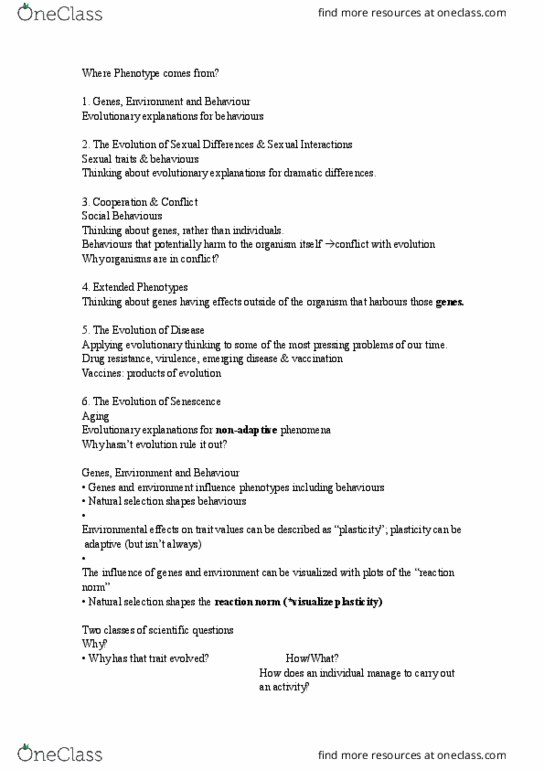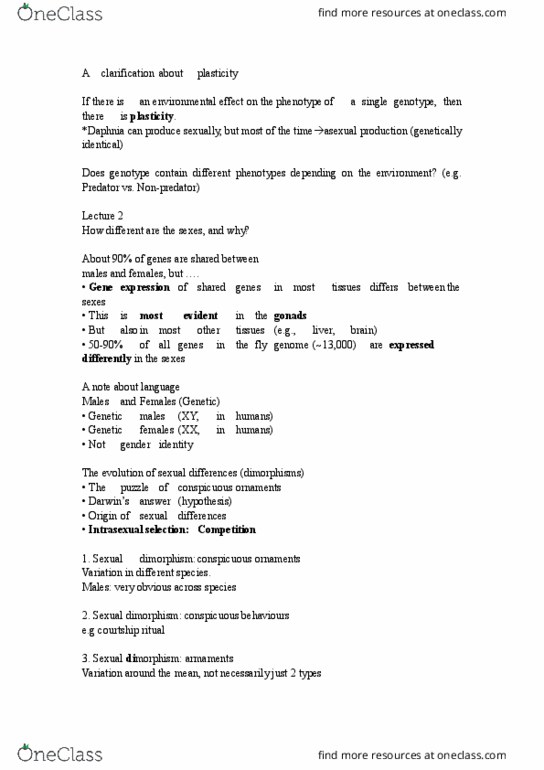BIO220H1 Lecture Notes - Lecture 2: Gene Expression, Frequency-Dependent Selection, Damselfly
BIO220H1 verified notes
2/18View all
A clarification about plasticity
If there is an environmental effect on the phenotype of a single genotype, then
there is plasticity.
*Daphnia can produce sexually, but most of the time→asexual production (genetically
identical)
Does genotype contain different phenotypes depending on the environment? (e.g.
Predator vs. Non-predator)
Lecture 2
How different are the sexes, and why?
About 90% of genes are shared between
males and females, but ….
• Gene expression of shared genes in most tissues differs between the
sexes
• This is most evident in the gonads
• But also in most other tissues (e.g., liver, brain)
• 50-90% of all genes in the fly genome (~13,000) are expressed
differently in the sexes
A note about language
Males and Females (Genetic)
• Genetic males (XY, in humans)
• Genetic females (XX, in humans)
• Not gender identity
The evolution of sexual differences (dimorphisms)
• The puzzle of conspicuous ornaments
• Darwin’s answer (hypothesis)
• Origin of sexual differences
• Intrasexual selection: Competition
1. Sexual dimorphism: conspicuous ornaments
Variation in different species.
Males: very obvious across species
2. Sexual dimorphism: conspicuous behaviours
e.g courtship ritual
3. Sexual dimorphism: armaments
Variation around the mean, not necessarily just 2 types
Peacock displays
Survival of the fittest?
Natural selection→ it’s a costing trait!
Why still exist?
Natural selection vs. Sexual selection
(-) survival/predation (+) mating success
Sexual Selection
“… depends on the advantage which certain
individuals have over other individuals of
the same sex and species, in exclusive
relation to reproduction.” Charles Darwin
Sexuallyselected traits function to enhance mating success
It is a subset of natural selection but it can
be useful to consider them separately
Natural selection: survival, reproductive rate →fitness
Sexual selection: number and quality of mates →fitness
Sexual selection
Intrasexual selection
• Competition (between males or between females)
Intersexual selection
• ‘Choosiness’ (“preferences” on the other sex)
What determines the strength of sexual selection?
Operational sex ratio determines→mating competition determines→sexual selection
Operational sex ratio
few females → more competitions among males
Few males→ more competitions among females
What determines the operational sex ratio?
Anything that alters the receptivity of one sex to mating, or their potential for
remating, canalter the operational sex ratio.
What drives sex differences in potential reproductive rates (PRR)?
→affect operational sex ratio
1. Gamete expenditure
Anisogomy=unequal-sized gametes
Egg: resource-rich, few, large, expensive to produce
Document Summary
A clarification about plasticity is plasticity. an environmental effect on the phenotype of. *daphnia can produce sexually, but most of the time asexual production (genetically identical) a single genotype, then. Does genotype contain different phenotypes depending on the environment? (e. g. predator vs. non-predator) How different are the sexes, and why? in most tissues differs between the liver, brain) the gonads in tissues (e. g. , the fly genome (~13,000) are expressed. About 90% of genes are shared between males and females, but : gene expression of shared genes sexes, this, but, 50-90% differently in the sexes evident other in is most also in most of all genes. Males and females (genetic: genetic males, genetic, not (xy, females (xx, gender identity in humans) in humans) puzzle of conspicuous ornaments. The evolution of sexual differences (dimorphisms: the, darwin"s answer (hypothesis, origin of sexual differences, intrasexual selection: competition dimorphism: conspicuous ornaments, sexual.






